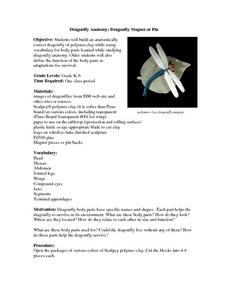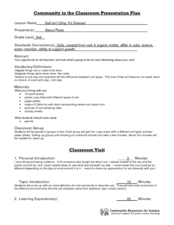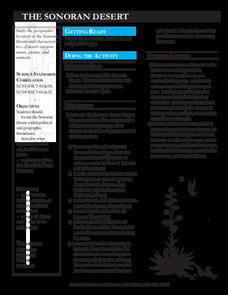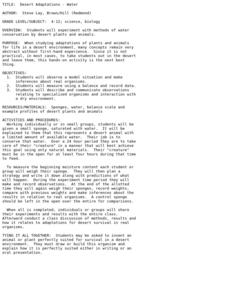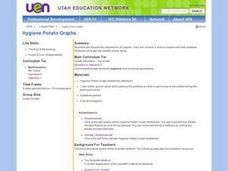Curated OER
Washing Germs Away
Students investigate germs. In this cross curriculum health and biology lesson plan, students listen to Old Black Fly by Jim Aylesworth and identify ways in which flies spread germs. Students discuss hand washing during a visit by the...
Curated OER
Endangered Species: Not Only Animals
Students research endangered animals and plants. In this biology lesson, students are read Will We Miss Them? Endangered Species by Alexandra Wright before they begin searching for information to complete an endangered species...
Curated OER
A Fish Tale
Students conduct an experiment. In this fish lesson, students discover how fish cells respond to fresh and salty water and if temperature effect the movement of a fish's gills. Students also identify the characteristics of a fish.
Curated OER
Dragonfly Anatomy: Dragonfly Magnet or Pin
Students build anatomically correct dragonflies of polymer clay, use vocabulary for body parts, and define the function of the body parts as adaptations for survival.
Curated OER
Pollution Solutions: Earth Day
Eighth graders explore water pollution. In this stewardship lesson, 8th graders draw comparisons between potable and impaired waters. Students use the Learning Link website to examine ways people are fighting pollution and then design an...
Curated OER
Process of Mitosis
Students discover through whole-class role play, the process of mitosis. They will all become a chromosome and demonstrate how they line up 23 to 23.
Curated OER
Energy Efficient Buildings
Seventh graders create plans for an energy efficient addition to the school. They work in small groups with each group having responsibility for examining one aspect of the problem. They create working diagrams and a model of their...
Curated OER
The Importance of Trees in the Rural Area: Planting a Snowfence
Students discuss the importance of trees and work together to plant a living snowfence. In this tree importance lesson, students discuss why trees are important in rural areas. They use mathematics and team work to plant a living snowfence.
Curated OER
Language Acquisition: How Babies Learn a Language
Students create a book for small children. In this literary instructional activity, students examine the qualities in children's literature that capture the attention of the child. They then work in small groups to create a book to share...
Curated OER
Soil Isn't Dirty; It's Diverse!
Second graders participate in a soil activity. In this soil lesson students complete a worksheet describing different soil types and the organic and inorganic things found in them.
Curated OER
The Sonoran Desert
Little learners examine a map of the southwestern United States and identify the Sonoran Desert. They locate different cities and rivers, determining whether or not each is found within this special ecosystem. A student handout is...
Curated OER
Oil Spill
Fourth graders watch a video about the types of products made from oil or oil used as energy to produce the product. In groups, they identify the positive and negative aspects of oil and participate in various activities. They use the...
Curated OER
Totally Termites
Students explore the world of termites, their adaptations, and anatomy. They examine the property risks of termites and how pest control professionals manage termite problems.
Curated OER
From the Gulf of Mexico to the Moons of Jupiter
Students compare deep ocean conditions to those found on the moons of Jupiter. In this Earth science lesson, students consider the possibilities and conditions needed to support simple life. Students examine the habitats and life found...
Curated OER
Stormy Weather
Fifth graders demonstrate their knowledge for how animals survive in natural environments when a storm occurs. For this science/writing lesson, 5th graders engage in a listening activity with the teacher. Additionally, students write a...
Curated OER
For Your Eyes Only
Students identify two major types of visible pollutants, smog, and particulate matter, They explain that air pollutants are generated during incomplete combustion. They measure and rank collectors from the most pollutants to the least...
Curated OER
Desert Adaptations: Water
Students experiment with methods of water conservation. In this water conservation lesson, students explore the importance of water for plants and animals in a desert biome.
Curated OER
Animal Adaptations
Tenth graders participate in an arthropod scavenger hunt. In groups of two, they identify and collect two specimens of arthropods in the school area, and create a table of all the specimens and what class they belong to.
Curated OER
Building a Clay Neuron
Students investigate and then build neurons in this lesson. They are examined as key parts of the brain and nervous system and seen as different from normal cells.
Curated OER
Where are the Dinosaurs?
Learners find the similarities of dinosaurs and the animals of today. In this dinosaurs lesson, students understand why dinosaurs have become extinct. Learners research and create dinosaur dioramas and finger puppets.
Curated OER
What is Energy?
Young scholars define energy and identify the different types that exist. They identify places they see, hear or feel energy. They understand the role of engineering in finding and testing sources of energy for the production of...
Curated OER
Do Salt Water Fish Drink?
Students conduct an experiment with potato cores and a sucrose solution to investigate how salt water fish process water. They develop a lab report of their experiment.
Curated OER
Tessellation
Students create an art piece incorporating tessellating shapes, translational symmetry, reflectional symmetry,and or rotational symmetry. They are asked if they know the definition of tessellation. If so, students are asked what shapes...
Curated OER
Hygiene Potato Graphs
Fifth graders discuss the importance of proper hygiene. After watching their teacher peel potatoes, they discuss why she was wearing rubber gloves. They demonstrate how to wash their hands properly and why one should never touch...



